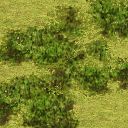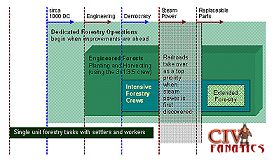 Forestry Operations
Forestry Operations
|
Quick Start Challenge Items below this point
Known Bugs and Glitches |
Before we look at some recommended forestry operations in these five phases, we want to look at the basic relationships between forest/jungle squares and the units which will normally interact with the squares.
Units that can perform Forestry Operations There are four units in the standard Civ3 game that can perform tasks that can alter forests and jungles.
The third and fourth units that could alter forests and jungle squares would be the two types of nuclear weapons that are included in the late stages of the game. These units are listed here for completeness, but will not be discussed because they do not provide a rational or cost effective solution to be considered in the game.
Task costs in terms of “Worker Turns” In the early game, you will usually be in the despotism form or government. Despotism grants you free support for four units for each town or city that you have in your empire, but you will be charged one gold per turn for unit support costs for each unit above that level. It is in your best interest to make full use of these free support costs while mentally remembering that workers have an effective opportunity cost of one gold unit per turn. Even if you manage your empire well and end up paying no unit support costs per turn, the workers are effectively using up one of your free gold units per turn and therefore you want to use that gold to produce something else of value. In rare cases your government will fall into anarchy and your workers will perform their tasks at half speed. The speed with which your workers complete tasks will also depend on if your civilization has the Industrious civilization trait or not. As of September 2002, the standard civilizations known to have the industrious trait include: America, China, Egypt, France, plus Carthage and the Ottomans from PTW. The table below displays the number of worker turns that would be required to complete a given set of tasks for workers with standard skills versus the enhanced industrious workers. The last two columns display the total worker turns required to move into that adjacent undeveloped square plus complete tasks shown.
Note 1: The numbers shown in parentheses in the table above will indicate where a round off effect could result in some different results when multiple workers of different nationalities can be applied to the same task. Note 2: You have to play close attention to the turns required to complete these tasks if you use the Civ3edit program to look at the factors that control how workers complete tasks. The required turns is set at 2x the number of turns that would be required in despotism, monarchy, or republic on flat terrain. The required turns for a worker to complete a task is always multiplied by the movement cost for the terrain type where a worker is currently located. For terrain types like forest and jungles, this creates a complicated multiplier effect that you must take into account when you look at the values in the editor. As an example, the editor sets the base number of turns to clear jungle at 16 which is then multiplied by the movement cost of jungles which is 3 and then divided by 2 to arrive at the base figure for despotism as shown in the table above {3 * 16 = 48 ; 48 / 2 = 24}.
Functional benefits of Forest and Jungle terrain types Forest and jungle squares have an impact on the movement and combat performance of units in the game. Wheeled units like catapults, cannons, and chariots cannot enter or pass through jungles without a road in place. If the terrain is in your territory or neutral territory and has a road present then your units gain the full increased mobility from the road. If the terrain is in the territory of another civilization and you do not have a “right-of-passage” agreement, then your units do not gain the FULL movement benefit of the roads. If you have wheeled units that need to move into jungle or mountain terrain in enemy territory, if there are roads present you may access the squares even though you do not gain the increased road movement bonus. Depending on the situation in the early game, this can be a significant issue. Forests and jungles also confer a 25% combat defensive bonus to any units which defend from these squares. Forest and jungle squares near your borders can slow down or prevent invading forces from reaching your cities quickly. They also provide increased defensive strength to the advancing enemy forces that can make it more difficult to turn back any offensive thrusts.
The locations for strategic resources that can appear in jungle or forest terrain are predetermined at the beginning of the game. When you clear the forest or jungle from a terrain square you have no impact on whether or not a strategic resource will initially appear in that square later in the game. The presence of forest or jungle in the square also has no impact on whether the strategic resource will be used up at some point in the game. You do not need to preserve large patches of jungle or forest to assure that you will have access to rubber or coal later in the game. Planting new forests will not increase your chance of having one of these resources initially appear in your territory when they are discovered by technology. I have not confirmed if resources that evaporate from one square and then reappear in another square might be affected by the initial or current terrain status. I have confirmed on numerous occasions that strategic resources (such as rubber) will appear in towns and/or terrain squares that have been changed to a new terrain type that would normally not allow that type of resource. Another game myth that is often raised in discussions is the myth that Forest and Jungle squares might decrease your chances of having pollution or global warming occur in or near your cities. This thought process is false because global warming and pollution events in the civ3 game are random statistical events that depend on the global population and the number of pollution units that are being generated in your cities. Next Topic – Early Forestry Tasks with Single Units
Other related topics:
|
|||||||||||||||||||||||||||||||||||||||||||||||||||||||||
 ©
2002 by cracker@CivFanatics.com
©
2002 by cracker@CivFanatics.com
All rights reserved. Please read the Terms
of Use.
Send mail to our webmaster with technical
questions about or potential problems with this web site.
 -
-  -
- 





